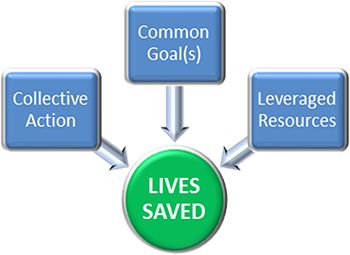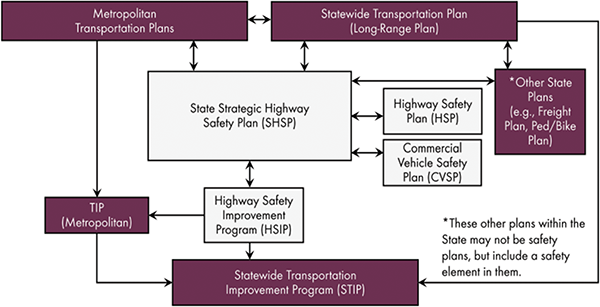The Maryland practice is discussed after the following introduction about SHSP integration.
Other states in this SHSP Integration Noteworthy Practices series: DE, ID, ME, ND, WA
Introduction to SHSP Integration
The Strategic Highway Safety Plan (SHSP) is a statewide-coordinated safety plan that provides a comprehensive framework for reducing the number of deaths and serious injuries on all public roads. In each State, the SHSP identifies the State's safety goals, objectives and key emphasis areas. It is intended to serve as an ‘umbrella’ plan that is integrated into other State transportation plans and guides the State's roadway safety investment decisions.
Integration Defined
Integration is the act of bringing together or incorporating various parts into a whole. Integration is relevant and important to a State's planning process because every State has numerous transportation plans; each one potentially addressing safety in a different way. The SHSP is the mechanism to bring these safety “parts” together to form a consistent and “whole” safety program for the State.
The Purpose and Benefits of Integration
The purpose of integration is to coordinate and focus the State's roadway safety efforts to maximize the State's ability to save lives.
Through integration, the safety needs of the State can be addressed more strategically and resources can be shared more effectively. As illustrated in Figure 1, integration encourages State partners to strive toward common goals, collectively implement appropriate strategies and actions, share resources to meet or exceed the State's goals and objectives, and most importantly to save lives.

Other potential integration benefits include:
- The use of consistent data and analysis methods.
- Improved allocation of resources to more effectively produce safety improvements.
- Improvements to safety culture across State, regional, and local agencies.
- A reduction in the administrative burden on States and local agencies.
Integration of Plans and Processes
State transportation plans and programs that the SHSP should be integrated with include the Statewide Long Range Transportation Plan (LRTP), Statewide Transportation Improvement Plan (STIP), State Highway Safety Improvement Programs (HSIPs), the Commercial Vehicle Safety Plan (CVSP), the Highway Safety Plan (HSP) Metropolitan Transportation Plans (TIPs), and various modal and regional transportation plans. The relationship of these plans is illustrated in Figure 2.

An integrated SHSP positions the State DOT and its safety partners to collectively address the State's safety challenges on all public roads through coordination and consistency among with the following State and regional plans and programs:
- LRTPs to promote a long-range vision that incorporates safety priorities.
- HSIP projects to be consistent with the SHSP emphasis areas and strategies.
- STIPS/TIPS to align programming of projects with SHSP strategies and countermeasures.
- CVSPs to facilitate exchange and collaboration between the commercial motor vehicle safety community and the broader safety community.
- HSPs to ensure a consistent, data-driven approach to improving highway safety, especially in SHSP emphasis areas.
In addition, the SHSP should integrate with city and county planning processes to ensure consideration of safety concerns on all road types.
SHSP Integration Indicators
Indicators that the SHSP and other transportation plans and processes are integrated include the following:
- Other transportation plans incorporate elements of the SHSP and include consistent and supporting safety goals, performance measures, objectives, and strategies.
- The priorities and goals of other transportation programs and plans are considered when developing the SHSP.
- Safety partners have access to and use of common safety data, analysis, and methods for determining safety priorities.
- The SHSP is developed with sustained input from disciplines and agencies representing the 4Es of safety (engineering, enforcement, education, and emergency medical services).
- Safety partners assist in the implementation of SHSP strategies.
- SHSP stakeholders and experts are included in other transportation planning processes.
- SHSP priorities and strategies are considered in project prioritization and programming.
- Various sources of funding are used to achieve safety goals.
- Progress towards safety goals is measured jointly and regularly.
Maryland
Background
The overall objective of Maryland's Strategic Highway Safety Plan (SHSP) is to reduce fatalities and Injuries. Maryland has adopted the vision of Towards Zero Death, with an overarching goal to halve fatalities in Maryland by 2030, and to 475 by 2015.
The SHSP is housed in the Highway Safety Office (HSO) under the direction and oversight of the highway safety coordinator. An Executive Council meets quarterly to receive SHSP updates, provide direction, review successes and discuss challenges. The Council is comprised of Maryland's: Secretary of the State Police; Motor Vehicle Administration (MVA) Administrator; State Highway Administration (SHA) Administrator; Deputy Secretary of the Department of Health and Mental Hygiene (DHMH); Department of Transportation's (MDOT) Director of Planning; Institute for Emergency Medical Services Systems (MIEMSS) Executive Director; and Transportation Authority Police.
SHSP Integration Practices
Common Goals, Strategies and Measures
The SHSP serves as the long-term, overarching highway safety plan for the State. It directs the priorities and strategies addressed by the State's other highway safety related plans and programs, including the Highway Safety Plan (HSP), Highway Safety Improvement Program (HSIP) and the Commercial Vehicle Safety Plan (CVSP).

The SHSP establishes broad strategies for the State. They are further defined into action steps that are developed by the SHSP emphasis area teams. These action steps form a selection of the projects outlined in the annual HSP, HSIP and CVSP. Keeping the strategies broad in nature allows a wide-range of buy-in from partners and an opportunity for all 4Es to participate as appropriate for their agencies.
Several key partners have committed their support for the SHSP through resolutions. The Maryland Chiefs of Police, Sheriff's Association, Association of County Health Officials, and the Institute for EMS Systems have all signed resolutions pledging their support to Maryland's Towards Zero Death vision, the SHSP, and helping to implement the SHSP strategies.
“The SHSP guides our overarching highway safety goals and efforts. The HSP, HSIP, CVSP and our other annual safety plans are where the rubber meets the road.”
- Thomas J. Gianni, Chief
Maryland Highway Safety Office
To achieve a fifty percent reduction in fatalities by 2030, a geometric mean reduction plan was devised to work backward from Maryland's future goal using 2008 as the benchmark year. This methodology was also used to set interim annual targets and various performance measures for the HSP & State Highway Administration Business Plans. In the future, Maryland will establish program area performance measures based on a rolling average, but the current methodology to set interim annual targets for the plans will remain the same.
Maryland has spent a great deal of effort elevating the SHSP in the eyes of the entire Department of Transportation. In prior years, the safety elements in the DOT's Statewide Long Range Transportation Plan and the Motor Vehicle Association's long range plan were not in line with the SHSP. Now the SHSP sets the tone and goals for these plans and the plans refer back to the SHSP. This is true for other State agency plans as well. For example, the Maryland Department of Health & Mental Hygiene and the Maryland State Police both have agency business plans with highway safety components. These safety components align with those in the SHSP. A big factor in accomplishing this is having the leadership from these agencies as members of the SHSP Executive Council.
Local Integration
Maryland is embarking in an effort to develop county roadway safety plans. The idea is to have local level plans that align with the SHSP, but with refined emphasis areas and strategies that have a local “flavor.” The State Highway Administration is taking the lead and is developing local data packages for counties.
For example, Hartford County has already developed a local SHSP and has set the stage for other county efforts. Like the state's SHSP, the Harford County SHSP follows a data driven, multidisciplinary approach involving the 4Es of traffic safety—education, emergency medical services, enforcement, and engineering. The plan provides a framework for reducing fatalities and serious injuries on all Harford County roads, and it establishes goals, objectives, and key emphasis areas in keeping with the goals and objectives of the SHSP. It also focuses on all road users to include bicyclists, drivers, motorcycle riders, and pedestrians.
Harford County will join Maryland in adopting the goal of the national initiative Toward Zero Deaths to reduce traffic fatalities by half by 2030. Harford County also used the same methodology as the state's SHSP to establish a benchmark for progress and will follow interim goals for fatality and injury reductions by 2015.
Key Accomplishments
- Broad SHSP strategies to help engage partners
- SHSP goals and strategies integrated with other State plans
- Coordinated target setting
- County SHSPs to help implement SHSP strategies at the local level
See these other SHSP Integration Noteworthy Practices:
Contact
Thomas J. Gianni
Maryland Highway Safety Office
(410) 787-4014
TGianni@mdot.state.md.us
